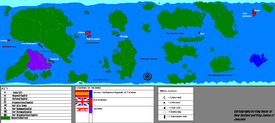MMES
The MMES was a rival cartographic organisation founded in April 2006 designed to challenge the dominant MCS, after accusations that the MCS was biased against Lovely Sector micronations. The MMES, standing for the Micronational Mapping and Economy Service was founded by Vilhelm von Benkern who was assisted by Oscar of New Oscland and James of Jamzinia. The organisation only completed three map releases before it collapsed, and the MCS' superiority as the Anglophone Sector's Mapping Organisation was reaffirmed. The MMES was important in CIS history as it nearly split the Confederacy in two over whether its members should be MMES or MCS members.
The MMES remains to this day, with the GSO and Micro-Monde, one of just three mapping organisations to attempt to challenge the MCS' dominance as the Anglophone Sector's mapping organisation.
Premise
The basic premise of the MMES was that the organisation would provide far more services to its members than the MCS so as to facilitate a standardised and centrally regulated system of economics and micronational warfare between its member nations. The organisation was also much more facilitating to newer nations at the time (of which there were many following the popularity of Lovely), asking only five weeks' activity before nations could claim land as opposed to the MCS' three months. This made the MMES immediately popular with many smaller nations but in many respects damaged its continuity and credibility, leading to its eventual collapse.
Economic Services
MMES nations, upon joining the organisation, were granted a GNP after an analysis of what their economic situation would be, and they were then permitted to start trade agreements with other member nations. Trade agreements were conducted with the agreement that one active citizen equalled one trade agreement. The MMES' definition of an active citizen was a citizen who posted at least once a week on a regular basis - if a citizen posted once a fortnight, they counted as a 'half citizen'. Nations' GNPs were announced once every three months, with trade initiated at the beginning of every month. A standard currency, the MMES dollar, was introduced for the purpose of buying military installations for RecWarring from the MMES forum (which would then be added to the MMES map) but many nations ignored the shared currency and simply created their own, pegged to the MMES Dollar at a rate of 1=1.
RecWar Services
The MMES world map was divided into over 1000 squares, each of ten miles square for the use of RecWar planning. Nations were all given an active population number judged by the MMES council which determined their power. Each active citizen allowed a nation to have either one military division, 100 planes, 10 tanks, or 10 battleships. A military unit as defined by the MMES RecWar charter consisted of 1000 troops, 1 plane, 1 tank, and 1 battleship. Each unit was able to move one square mile on the map grid per active citizen per day. The map would be updated daily to reflect movements throughout the RecWar squares. Invasion of an enemy nation was considered successful once the nation's capital city was occupied by the attacking force. When attacking armies occupied a city, they also occupied the surrounding 49 square miles. Once nations were fully defeated they were re-allocated one square on the MMES map to start afresh and rebuild their economy and military.
An unusual feature of the MMES was that of the MMES Peacekeeping Force, a neutral military force owned and run by the administrators of the organisation which would be activated if an attacking force had occupied a much smaller and weaker nation and not either advanced or retreated from that nation's territory. The MMES never had an oppurtunity to put these rules into practice as it died before any of its members started a conflict.
Maps
MMES maps made extensive use of AutoRealm fantasy mapping software, but were criticised for being generally of a lower quality than their MCS counterparts. Infighting between the MMES administrators about the exact landmasses and continents to be included on the final physical map infuriated some member nations, with Jamzinia involuntarily moving location three times. The maps also made use of a similar graphic design used by the CIS, reflecting the high proportion of MMES member nations who were also CIS members.
The MMES world or Wuurld as it was known, never documented fully the names of continents and landmasses but did publish a list of seas, oceans, and other major bodies of water, which included:
- El Canal
- Klemmen Sea
- Groß Ocean
- The Galafar Strip
- Warwark Ocean
- Malapharna Oceam
- Südliche Wasser
Criticism
Apart from the relatively low quality of maps produced by the MMES, concerns were also voiced about how sustainable a centrally-administered RecWar, mapping, and economics system really was. Running the MMES was time-consuming and it was also felt reduced the independence of member nations who wanted to be able to administer their own economic affairs. A lack of continuity and general acceptance of the MMES was only made worse when it was declared that MCS nations could not also have MMES land. Due to the far higher number of established micronations in the MCS, MMES member nations began to leave, feeling their reputation and ability to interact with all nations in the Anglophone Sector rather than just some was more important than their loyalty to the MMES.
Former Members
Micronations which were once MMES member nations include:
- FCR T'aishen
- Jamzinia
- New Oscland
- Paradisia
- Kabah
- New Britannia
- Ruasoza
